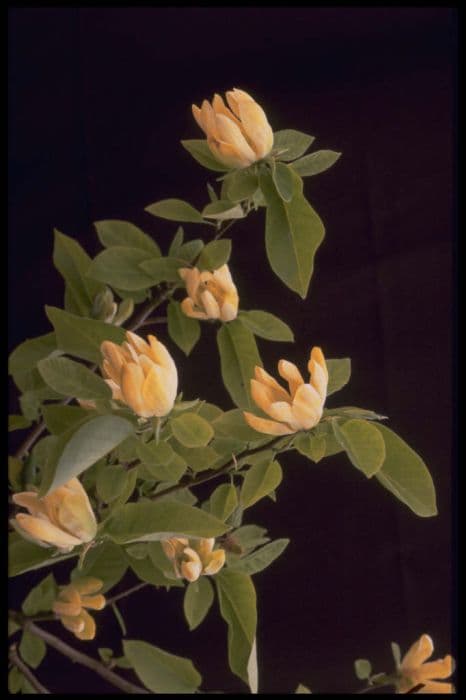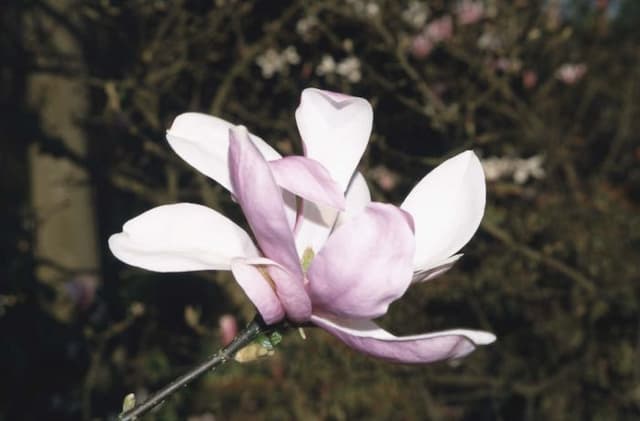Milky Way Magnolia Magnolia 'Milky Way'

ABOUT
The Magnolia 'Milky Way' is a captivating plant known for its spectacular floral display. This plant produces large, creamy white flowers that are renowned for their beauty and fragrance. The blossoms typically boast a goblet or star-like shape, creating a stunning visual appeal when they unfurl from their fuzzy buds in the spring. Each flower consists of multiple petals that are soft and thick, providing a lush and velvety texture. The petals may have a subtle hint of pink at the base, contributing to the overall allure of the bloom. The leaves of the 'Milky Way' are glossy and leathery, displaying a rich green color that provides a striking contrast against the white flowers. The foliage has an ovate to elliptical shape, with smooth margins, and emerges just as the flowering season begins, creating a backdrop that highlights the floral display. As a deciduous plant, the Magnolia 'Milky Way' will shed its leaves in the fall, after they've turned to warm shades of bronze or yellow, adding a touch of autumnal charm to the garden. This magnolia variety is also recognized for its symmetrical and pyramidal growth habit, which allows it to serve as a focal point in the landscape. The branching structure is robust, with the branches spreading outward as much as they ascend, contributing to the plant's overall form and presence in the garden setting.
About this plant
 Names
NamesSynonyms
Milky Way Magnolia, Milky Way Star Magnolia.
Common names
Magnolia 'Milky Way'
 Toxicity
ToxicityTo humans
The Magnolia 'Milky Way', commonly known as simply Magnolia, is not widely recognized as a toxic plant to humans. There is no common documentation of this ornamental plant causing poisoning upon ingestion. However, as with any plant, individual allergies or sensitivities can occur, and caution should be taken to avoid consuming plant material that is not meant for human consumption.
To pets
The Magnolia 'Milky Way', commonly referred to as Magnolia, is not commonly recognized as toxic to pets. This plant is generally considered to be of low toxicity, and there is limited evidence to suggest that pets, such as dogs and cats, would experience poisoning upon ingesting parts of this plant. Nonetheless, it is always a good practice to prevent pets from ingesting plants not intended for them, as individual animals may react differently, and gastrointestinal upset can occasionally occur.
 Characteristics
CharacteristicsLife cycle
Perennials
Foliage type
Deciduous
Color of leaves
Green
Flower color
White
Height
20-25 feet (6-7.6 meters)
Spread
10-15 feet (3-4.6 meters)
Plant type
Tree
Hardiness zones
5-8
Native area
Asia
Benefits
 General Benefits
General Benefits- Aesthetic Appeal: Milky Way magnolias are known for their large, fragrant, white flowers that can add a spectacular display to any garden or landscape.
- Year-Round Interest: They provide visual interest throughout the year with flowers in spring, green leaves in summer, and interesting seed pods in the fall.
- Shade Provider: Their dense foliage can offer a cool, shady area during hot summer months, making them a practical choice for landscapes.
- Wildlife Attraction: The flowers can attract pollinators like bees and butterflies, while the seeds can attract birds, enhancing the biodiversity of the garden.
- Low Maintenance: Once established, the Milky Way magnolia is relatively low maintenance, requiring minimal pruning and care.
- Drought Tolerance: They are quite resilient in the face of drought, making them suitable for regions with less rainfall.
- No Serious Pests or Diseases: Typically, these trees have no serious pest or disease problems, making them a hassle-free addition to the garden.
 Medical Properties
Medical Properties- This plant is not used for medical purposes.
 Air-purifying Qualities
Air-purifying QualitiesThis plant is not specifically known for air purifying qualities.
 Other Uses
Other Uses- Floral arrangements: The flowers of Magnolia can be cut and used in floral arrangements for their elegant shape and pleasant fragrance, adding a touch of luxury to any bouquet.
- Natural dye: The bark and flowers of the Magnolia can be used to create natural dyes for textiles, yielding subtle colors that are eco-friendly.
- Photography subject: Gardeners and photographers often use Magnolia trees as a subject for photography, capturing the beauty of the blooms which are considered a sign of spring.
- Crafting material: Seed pods and cones from Magnolia can be dried and used in crafting, such as in wreath making or as natural decor elements.
- Perfumery: The scent of Magnolia flowers can be extracted and used in making perfumes and scented oils, albeit through a complex process.
- Culinary garnish: While not commonly consumed, Magnolia petals can be used as an elegant, edible garnish for sophisticated dishes in gourmet cuisine.
- Wedding decor: Magnolia flowers and branches can be incorporated into wedding decor for a romantic and southern charm feel, especially popular in southern United States weddings.
- Screen printing: The distinct shape of Magnolia leaves and flowers can be used as motifs in the art of screen printing on fabrics or paper.
- Bonsai cultivation: Some horticulturists train Magnolia trees into bonsai for ornamental purposes, displaying them as a symbol of patience and diligence.
- Art inspiration: The striking form and color of Magnolia blossoms inspire artists to create paintings, illustrations, and other art pieces celebrating natural beauty.
Interesting Facts
 Feng Shui
Feng ShuiMagnolia is not used in Feng Shui practice.
 Zodiac Sign Compitability
Zodiac Sign CompitabilityMagnolia is not used in astrology practice.
 Plant Symbolism
Plant Symbolism- Nobility: Magnolias are often associated with nobility, representing dignity and poise.
- Purity: The white flowers of the 'Milky Way' magnolia symbolize purity and innocence.
- Perseverance: Magnolias are resilient and can withstand harsh conditions, symbolizing persistence and endurance.
- Beauty: Known for their striking appearance, magnolias represent beauty and magnificence.
- Femininity: The soft and subtle nature of the magnolia's blooms can symbolize femininity and gentleness.
 Water
WaterSouthern magnolias, like 'Milky Way', should be watered thoroughly but infrequently, allowing the soil to partially dry out between watering. During the first growing season, water your 'Milky Way' weekly with about 1.5 gallons per watering to help establish the root system. Once established, reduce watering to every two to three weeks, depending on weather conditions. In periods of drought or extreme heat, you may need to water more frequently to maintain moist, but not waterlogged, soil conditions.
 Light
LightThe 'Milky Way' southern magnolia flourishes in full sun to partial shade. It is best to plant it where it will receive at least four hours of direct sunlight per day. Dappled sunlight is ideal for young trees, while mature magnolias can handle more sun. Avoid deep shade locations, as this can hinder the plant's growth and flowering potential.
 Temperature
TemperatureSouthern magnolias like 'Milky Way' prefer moderate temperatures and can survive a range from about 0 to 100 degrees Fahrenheit. Optimal growth occurs when temperatures are between 70 and 90 degrees Fahrenheit. They can tolerate short periods of colder weather down to 0 degrees but should be protected from harsh, cold winds.
 Pruning
PruningPrune the 'Milky Way' southern magnolia primarily for health by removing dead or damaged limbs, ideally in late winter or early spring before new growth starts. It may also be pruned to shape the tree or reduce its size; however, be cautious as this can reduce flowering. Pruning should be done every 2-3 years or as needed for shaping.
 Cleaning
CleaningAs needed
 Soil
SoilMilky Way Magnolia thrives in moist, well-drained, slightly acidic to neutral soil with a pH of 5.5 to 7. A good soil mix can be created using equal parts of loamy soil, peat, and compost to provide rich nutrients and proper drainage.
 Repotting
RepottingMilky Way Magnolias grown in containers may need repotting every 2 to 3 years. They should be repotted if they become root-bound or if the soil has degraded, ideally in late winter or early spring.
 Humidity & Misting
Humidity & MistingMilky Way Magnolia prefers moderate to high humidity levels, generally around 50% or higher. However, it is adaptable to less humid conditions provided it is not exposed to dry winds.
 Suitable locations
Suitable locationsIndoor
Place near a window, moderate light, water well.
Outdoor
Full sun to partial shade, protect from harsh winds.
Hardiness zone
5-9 USDA
 Life cycle
Life cycleThe Magnolia 'Milky Way', also known as Milky Way Magnolia, begins its life cycle as a seed that germinates in the spring, typically in moist, well-drained soil and under partial to full sunlight conditions. The seedling emerges and grows into a young plant with a single main stem, at which point it gradually develops a branching structure. Over several years, the Milky Way Magnolia matures and reaches its flowering stage, producing large, fragrant, white to creamy blossoms each spring or early summer. After pollination, typically by beetles which are attracted to the flowers, the plant produces cone-like fruit that houses red-orange seeds. These seeds are then dispersed, often by birds and other animals, to start a new cycle. Throughout its lifetime, which can span several decades, the Magnolia 'Milky Way' will experience seasonal growth cycles, undergoing dormancy in the winter and resuming vigorous growth in the spring and summer months.
 Propogation
PropogationPropogation time
Spring-Early Summer
The most popular method for propagating the Magnolia 'Milky Way' is by semi-hardwood cuttings. This process typically takes place in late summer, after the new growth has begun to harden but is not yet mature. A cutting of about 4 to 6 inches (10 to 15 centimeters) is taken from the plant, cutting just below a node. The leaves on the lower half of the cutting are removed, and the cut end is often dipped in a rooting hormone to enhance root development. Then the cutting is placed in a potting medium that is kept moist and in a warm environment with indirect light. Rooting can take several weeks, and it is important to maintain humidity around the cutting during this period. Once established, the new Magnolia 'Milky Way' plant can be transplanted to a more permanent location.




![Magnolia [Black Tulip]](/_next/image?url=https%3A%2F%2Fplants-admin.emdemapps.com%2Fimages%2Fplants%2F%2Fimages%2F604b590290fc7.png&w=640&q=75)




